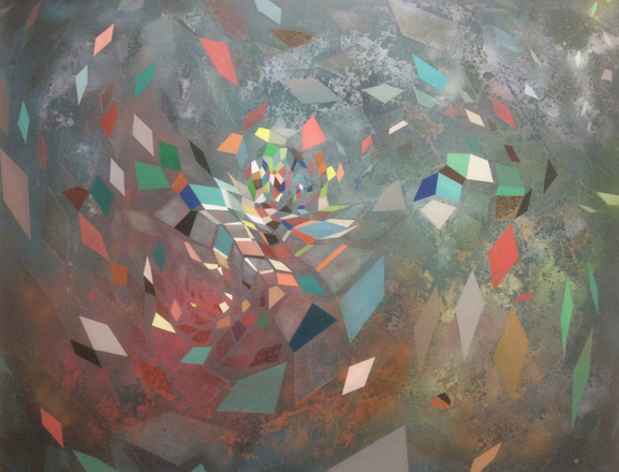“Trajectory” Exhibition
Van Der Plas Gallery

This event has ended.
“Trajectory, featuring the paintings of Jon Elliott, Paul Corio, and Rob de Oude, is an exhibition of
patterns, systems, and connections through the verisimilitude of the human hand. The plastic and the
precise trajectory of a line as a perfect geometric concept exists only as a mental notation. The ideal of
geometry finds practical expression in urban planning and human dwellings mediated by the solidity of
matter, and through our charting of the systems of macro and microcosmic nature.
All three artists embrace the ideal of geometric expression through line and plane suggesting depth
through complex color interactions. All the work is meticulously crafted from the mechanistic hand
painted linear perfection of Rob de Oude to the complex planar and color interactions of Paul Corio.
Jon Elliott takes us on a journey through deep space from precision to dissolution of form. The desire
for perfection in the art is reconciled by our own human transience, creating work that expresses the
momentary beauty of the time/space. “Trajectory” traces a lineage through the history of painting, from
the movements of the Wiener Werkstätte and the Bauhaus, to the present renaissance of abstract
painting currently taking place in New York. Trajectory expresses the interconnection, “Verbindung.”
-Debra Drexler, Curator
Rob de Oude studied painting, sculpture and art history at the Hoge School voor de Kunsten in
Amsterdam and SUNY Purchase, NY. He has shown in the US and abroad, notably at:Galerie
Gourvennec Ogor in Marseille, France, Storefront Bushwick in Brooklyn, NY, McKenzie Fine Art in
New York, NY, BRIC Rotunda in Brooklyn, NY, Galerie van den Berge in Goes, NL, City Ice Arts in
Kansas City, MO, and has participated in several art fairs in New York, Miami and Paris. De Oude has
been featured a.o. in the NY Post, L Magazine, Artnet Magazine, NYArts Magazine, The New
Criterion, ARTNews and has in 2014 been noted by Brooklyn Magazine as one of the 100 influential
people in Brooklyn culture. He has his studio in Brooklyn, NY, and is co-director of Transmitter, also in
Brooklyn, NY. He states: “The paintings and drawings I make are composed of meticulously placed
repeated lines. The lines reveal geometric shapes and patterns. Repeatedly using a single unit, a
straight line, displays the infinite possibilities of a synchronized effort. Overlapping bands and grids of
colors and collisions of angled lines create an elusive sense of space, shifting colors, moires and
deceptively bending lines. I mix an intuitive use of color, rhythm, composition and layering choices with
a systematic mode of painting. These types of juxtapositions between intuition and methodology, are
part of seeking a sense of orchestrated balance, with a single line as the building unit.”
Paul Corio is a painter who lives and works in New York City. He has shown at McKenzie Fine Art,
Strorefront Ten Eyck, Brian Morris Gallery, Ventana244, Allegra LaViola Gallery, and Paris Concret.
He holds a masters degree from Hunter College, and is a part-time faculty member at the Parsons
School of Design. “My work is about color - more specifically, the use of disciplined color sequences in
order to articulate space and to create the illusion of light and atmosphere. My work is not “pure” in the
modernist sense, but it is primarily visual. I feel a tremendous affinity for the baroque, and for the
Venetian renaissance. I sometimes use systems (over and above the sequential use of color) and
other times I simply improvise using color sequence as a basis. I freely mix these two approaches -
systems are only interesting to me to the extent that they create a compelling image. If they don’t I
discard or amend them to that end. I use geometry almost exclusively, but I feel no special attachment
to it per se - it’s a generic figuration that allows the color to come to the fore as the picture’s true
content. Color wants very much to take a supporting role, to become the surface property of an object;
in other words, red seeks to be a characteristic of apples, Ferraris or fire hydrants, not as an entity
unto itself. The relative blandness of squares, circles, triangles, diamonds, etc. allows color to take a
leading role.”
Media
Schedule
from February 13, 2015 to March 08, 2015
Opening Reception on 2015-02-13 from 18:00 to 20:00